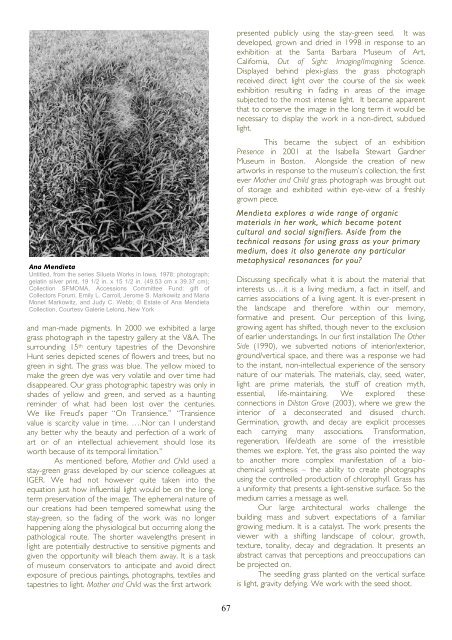M - Antennae The Journal of Nature in Visual Culture
M - Antennae The Journal of Nature in Visual Culture
M - Antennae The Journal of Nature in Visual Culture
Create successful ePaper yourself
Turn your PDF publications into a flip-book with our unique Google optimized e-Paper software.
Ana Mendieta<br />
Untitled, from the series Silueta Works <strong>in</strong> Iowa, 1978; photograph;<br />
gelat<strong>in</strong> silver pr<strong>in</strong>t, 19 1/2 <strong>in</strong>. x 15 1/2 <strong>in</strong>. (49.53 cm x 39.37 cm);<br />
Collection SFMOMA, Accessions Committee Fund: gift <strong>of</strong><br />
Collectors Forum, Emily L. Carroll, Jerome S. Markowitz and Maria<br />
Monet Markowitz, and Judy C. Webb; © Estate <strong>of</strong> Ana Mendieta<br />
Collection, Courtesy Galerie Lelong, New York<br />
and man-made pigments. In 2000 we exhibited a large<br />
grass photograph <strong>in</strong> the tapestry gallery at the V&A. <strong>The</strong><br />
surround<strong>in</strong>g 15 th century tapestries <strong>of</strong> the Devonshire<br />
Hunt series depicted scenes <strong>of</strong> flowers and trees, but no<br />
green <strong>in</strong> sight. <strong>The</strong> grass was blue. <strong>The</strong> yellow mixed to<br />
make the green dye was very volatile and over time had<br />
disappeared. Our grass photographic tapestry was only <strong>in</strong><br />
shades <strong>of</strong> yellow and green, and served as a haunt<strong>in</strong>g<br />
rem<strong>in</strong>der <strong>of</strong> what had been lost over the centuries.<br />
We like Freud’s paper “On Transience.” “Transience<br />
value is scarcity value <strong>in</strong> time. ….Nor can I understand<br />
any better why the beauty and perfection <strong>of</strong> a work <strong>of</strong><br />
art or <strong>of</strong> an <strong>in</strong>tellectual achievement should lose its<br />
worth because <strong>of</strong> its temporal limitation.”<br />
As mentioned before, Mother and Child used a<br />
stay-green grass developed by our science colleagues at<br />
IGER. We had not however quite taken <strong>in</strong>to the<br />
equation just how <strong>in</strong>fluential light would be on the longterm<br />
preservation <strong>of</strong> the image. <strong>The</strong> ephemeral nature <strong>of</strong><br />
our creations had been tempered somewhat us<strong>in</strong>g the<br />
stay-green, so the fad<strong>in</strong>g <strong>of</strong> the work was no longer<br />
happen<strong>in</strong>g along the physiological but occurr<strong>in</strong>g along the<br />
pathological route. <strong>The</strong> shorter wavelengths present <strong>in</strong><br />
light are potentially destructive to sensitive pigments and<br />
given the opportunity will bleach them away. It is a task<br />
<strong>of</strong> museum conservators to anticipate and avoid direct<br />
exposure <strong>of</strong> precious pa<strong>in</strong>t<strong>in</strong>gs, photographs, textiles and<br />
tapestries to light. Mother and Child was the first artwork<br />
67<br />
presented publicly us<strong>in</strong>g the stay-green seed. It was<br />
developed, grown and dried <strong>in</strong> 1998 <strong>in</strong> response to an<br />
exhibition at the Santa Barbara Museum <strong>of</strong> Art,<br />
California, Out <strong>of</strong> Sight: Imag<strong>in</strong>g/Imag<strong>in</strong><strong>in</strong>g Science.<br />
Displayed beh<strong>in</strong>d plexi-glass the grass photograph<br />
received direct light over the course <strong>of</strong> the six week<br />
exhibition result<strong>in</strong>g <strong>in</strong> fad<strong>in</strong>g <strong>in</strong> areas <strong>of</strong> the image<br />
subjected to the most <strong>in</strong>tense light. It became apparent<br />
that to conserve the image <strong>in</strong> the long term it would be<br />
necessary to display the work <strong>in</strong> a non-direct, subdued<br />
light.<br />
This became the subject <strong>of</strong> an exhibition<br />
Presence <strong>in</strong> 2001 at the Isabella Stewart Gardner<br />
Museum <strong>in</strong> Boston. Alongside the creation <strong>of</strong> new<br />
artworks <strong>in</strong> response to the museum’s collection, the first<br />
ever Mother and Child grass photograph was brought out<br />
<strong>of</strong> storage and exhibited with<strong>in</strong> eye-view <strong>of</strong> a freshly<br />
grown piece.<br />
Mendieta explores a wide range <strong>of</strong> organic<br />
materials <strong>in</strong> her work, which become potent<br />
cultural and social signifiers. Aside from the<br />
technical reasons for us<strong>in</strong>g grass as your primary<br />
medium, does it also generate any particular<br />
metaphysical resonances for you?<br />
Discuss<strong>in</strong>g specifically what it is about the material that<br />
<strong>in</strong>terests us…it is a liv<strong>in</strong>g medium, a fact <strong>in</strong> itself, and<br />
carries associations <strong>of</strong> a liv<strong>in</strong>g agent. It is ever-present <strong>in</strong><br />
the landscape and therefore with<strong>in</strong> our memory,<br />
formative and present. Our perception <strong>of</strong> this liv<strong>in</strong>g,<br />
grow<strong>in</strong>g agent has shifted, though never to the exclusion<br />
<strong>of</strong> earlier understand<strong>in</strong>gs. In our first <strong>in</strong>stallation <strong>The</strong> Other<br />
Side (1990), we subverted notions <strong>of</strong> <strong>in</strong>terior/exterior,<br />
ground/vertical space, and there was a response we had<br />
to the <strong>in</strong>stant, non-<strong>in</strong>tellectual experience <strong>of</strong> the sensory<br />
nature <strong>of</strong> our materials. <strong>The</strong> materials, clay, seed, water,<br />
light are prime materials, the stuff <strong>of</strong> creation myth,<br />
essential, life-ma<strong>in</strong>ta<strong>in</strong><strong>in</strong>g. We explored these<br />
connections <strong>in</strong> Dilston Grove (2003), where we grew the<br />
<strong>in</strong>terior <strong>of</strong> a deconsecrated and disused church.<br />
Germ<strong>in</strong>ation, growth, and decay are explicit processes<br />
each carry<strong>in</strong>g many associations. Transformation,<br />
regeneration, life/death are some <strong>of</strong> the irresistible<br />
themes we explore. Yet, the grass also po<strong>in</strong>ted the way<br />
to another more complex manifestation <strong>of</strong> a biochemical<br />
synthesis – the ability to create photographs<br />
us<strong>in</strong>g the controlled production <strong>of</strong> chlorophyll. Grass has<br />
a uniformity that presents a light-sensitive surface. So the<br />
medium carries a message as well.<br />
Our large architectural works challenge the<br />
build<strong>in</strong>g mass and subvert expectations <strong>of</strong> a familiar<br />
grow<strong>in</strong>g medium. It is a catalyst. <strong>The</strong> work presents the<br />
viewer with a shift<strong>in</strong>g landscape <strong>of</strong> colour, growth,<br />
texture, tonality, decay and degradation. It presents an<br />
abstract canvas that perceptions and preoccupations can<br />
be projected on.<br />
<strong>The</strong> seedl<strong>in</strong>g grass planted on the vertical surface<br />
is light, gravity defy<strong>in</strong>g. We work with the seed shoot.












